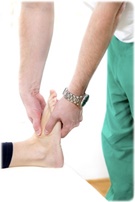 Common Ailments
Common AilmentsThe medical specialty that focuses on the bones, muscles and nerves of the foot and ankle is called podiatry. For many people, the health of their feet is something they will never think about until an injury or chronic pain issue leads them to needing a specialist. In fact, the human foot is an amazingly well designed system that keeps us going for our whole lives. The foot and ankle contains 28 bones, 33 muscles, 5 major blood veins, dozens of arterial branches, 4 major nerves and thousands of nerve endings. It is complex but with a little care, most people can enjoy healthy walking, running, dancing and sports all their lives.
The question most people ask themselves with any surgery is, “will the cure be worse than the disease?” In the case of foot surgery, choosing not to undergo the procedure often means choosing chronic pain that can be debilitating and lead directly and indirectly to serious, even life-threatening complications. Most podiatric procedures, when performed by an expert, are painless, fairly quick, and have a manageable recovery time. So choosing between chronic pain and an opportunity to get your healthy and active lifestyle back may seem like a no-brainer, but you should always consult with your foot doctor to see how your individual case will be.
Most foot surgeries have a recovery time of several weeks. Many factors come in to play, such as the type of surgery, the age and general health of the patient, whether or not bone reconstruction was involved, and so on. Just like any major procedure, foot surgery should be undertaken with care and with the advice of a highly qualified and experienced doctor.
At Summit Foot & Ankle Clinic, our doctors are proponents of the most cutting-edge techniques to give our patients the best possible course of action. Dr. Royall is an expert in advanced non-surgical foot treatments that can be less invasive, have faster recovery times, and lead to fewer complications.
Podiatric sports medicine focuses on the care of athletes for prevention, repair, and recovery of injury to the foot or ankle sustained in sports activities. The most common injuries sustained by athletes, including high school students, are damage to the ankle, foot and knee. The types of sports most likely to incur injuries in the foot or ankle are competitive team sports played in an enclosed space, such as basketball and volleyball. Sports that involve running on grass such as football, soccer and field hockey are also likely to cause injuries requiring the attention of a podiatric sports medicine specialist. Track and field events and even cheerleading also have a high rate of injury.
Student athletes often perform better academically than their non-competitive peers, and the benefits of team sports often include better social and psychological adjustment as well as physical fitness. However, the high rate of injury of many sports may lead to student athletes, even in high school or middle school, needing to see a sports medicine podiatrist. They are the specialists with the most expertise and knowledge in how to help recover from injuries like sprains and damaged tendons or broken bones in the foot or ankle. A sports medicine specialist will have the best chance at getting your student athlete back on the field as quickly as possible without risking long-term injury.
Interesting fact: Over 300,000 high school athletes experience an ankle injury each year. The most at-risk sports for ankle sprains are competitive team sports like basketball, soccer and football. Injuries are more likely to occur during competition than during practice.
Interesting fact: Many people are reluctant to undergo foot surgery, but an impaired foot can limit the ability to exercise leading to life-threatening complications including deep vein thrombosis (DVT) and heart disease.